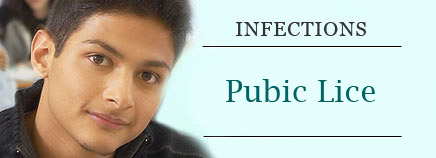
About Pubic Lice
Pubic lice (often called “crabs” because of their crab-like appearance under a microscope) are six-legged creatures that most commonly infest hair in the pubic area, although they also can infest other body hair. In most cases, pubic lice are transmitted sexually from the pubic hair of one person to another. But lice can be contracted in other ways, too — from infested clothing, towels, and bedding.

Typically, pubic lice can be treated at home. But if someone in the house has them, it’s important to take precautions so that they don’t spread.
Symptoms
Although it’s possible to be infested and have no symptoms, people with pubic lice usually experience itchiness. This can worsen at night when the lice become active and bury their heads inside pubic hair follicles to feed on a person’s blood.
Sometimes, lice bites can also cause the infested area to become inflamed and discolored because of a reaction to the proteins in the saliva of the lice. Constant itching and scratching can cause the area to become raw and lead to a secondary bacterial infection. Scratching also can help the pubic lice to spread.
If the infestation consists of many adult lice, symptoms may be noticeable immediately. But if the infestation initially involves a few lice that then lay eggs, a person may not experience any symptoms for 2 to 4 weeks until the eggs hatch.
In young children, pubic lice may also be a cause of blepharitis (irritation or infection of the eyelids). So, a child’s eyelashes should be examined with a high-powered magnifying glass if lice are suspected.
Contagiousness
Pubic lice can live 1 to 2 days away from a human body. But contrary to what some people may think, they’re rarely transmitted from furniture or toilet seats because the lice that fall from the body are usually injured or dying. Unlike fleas, lice can’t jump from person to person. And they can’t be contracted from animals.
Prevention
Because the lice can sometimes be contracted from bedding and towels used by someone who is infested, it’s important to avoid contact with any item — including clothing — that the person has used.
More commonly, pubic lice infestation is spread through sexual contact, so the best way to prevent it is to abstain from having sexual contact. Sexual contact with more than one partner or with someone who has more than one partner increases the risk of contracting any sexually transmitted disease (STD).
When properly and consistently used, condoms decrease the risk of STDs. However, because condoms don’t cover the area with pubic hair, they are not good protection against pubic lice.
A teen who is being treated for pubic lice also should be tested for other STDs, and should have time alone with the doctor to openly discuss issues like sexual activity. Not all teens will be comfortable talking with parents about these issues. But it’s important to encourage them to talk to a trusted adult who can provide the facts.
Treating Pubic Lice
A teen who might have pubic lice should see a doctor right away. If the doctor diagnoses pubic lice, your child may be prescribed medication or told to buy an over-the-counter medicine that kills the lice and their eggs. The important thing to remember is that the treatment may need to be repeated after 7 to 10 days to kill any lice not eliminated the first time.
Also, dry clean or use very hot water and a hot dryer cycle to wash and dry all affected bedding, towels, or recently worn clothing to properly kill the lice and their eggs. Any sexual partners from the last month should also check for pubic lice immediately. Although condoms help protect against other STDs, a partner could still get pubic lice because the condom does not cover the entire pubic area.
Getting Help
If your teen is thinking of becoming sexually active or already has started having sex, it’s important to discuss it. Make sure your teen knows how STDs can be spread (during anal, oral, or vaginal sex) and that these infections often don’t have symptoms, so a partner might have an STD without knowing it.
It can be difficult to talk about STDs, but just as with any other medical issue, teens need this information to stay safe and healthy. Provide the facts, and let your child know where you stand.
It’s also important that all teens have regular full physical exams — which can include screening for STDs. Your teen may want to see a gynecologist or a specialist in adolescent medicine to talk about sexual health issues. Community health organizations and sexual counseling centers in your local area also may be able to offer some guidance.

